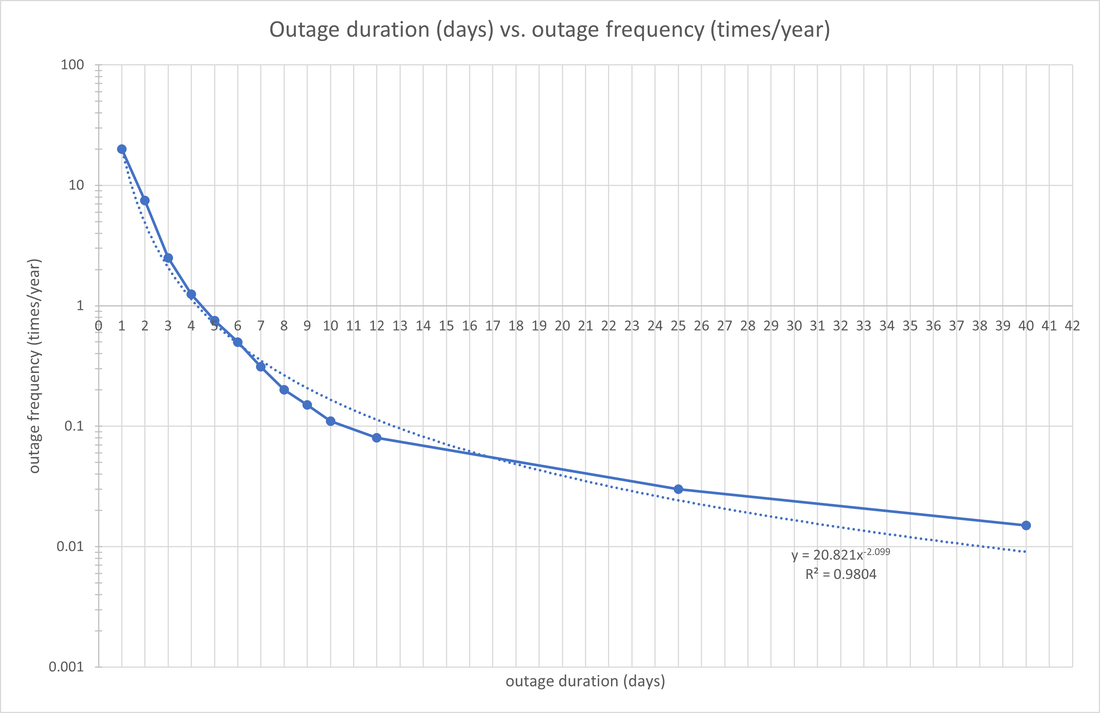|
The goal of 100% renewable energy from intermittent wind, solar and battery technology is firmly established in California and Germany. These are the leaders that generally determine where the US and Europe are headed. The 100% goal was established by environmentalists and academics who back the achievability of 100% renewable energy with studies based on elaborate simulations.
The trouble with elaborate simulations is that their assumptions are opaque. Most simulate generation and consumption but assume transmission that connects the two. Intermittent generation is simulated using a limited history. The combination of these assumptions assume massive transmission over unrealistic long distances and omits rare extreme events. The graph above shows approximate yearly solar intermittency data for events affecting the entire state of California. The horizontal axis represents the duration in days of outages. The vertical axis represents the number of outages. The first data point on the left shows 20 outage events of duration one day. The point on the extreme right shows one event lasting around forty days every 150 years. The point crossing the horizontal axis shows one event lasting four days. On average events exceeding four days occur with rapidly decreasing frequency and are unlikely in any given year. These intermittency events mostly occur due to winter storms. The worst storm recorded in California occurred in the winter of 1861/1862 when it rained for 40 straight days. The geological record shows that storms of this magnitude occur around every 150 years. The phenomenon driving these events are known as atmospheric rivers which transfer tropical moisture in quantities exceeding the flow of the Mississippi and which occur randomly. Other points on the graph come from recorded storm events, mostly atmospheric river events of shorter duration. Current solar tries to deal with these events through storage and excess generation and distribution. To simply supply nighttime electricity without consideration of outages takes about 25% of peak DC generation capacity. So 1 GW of generation needs approximately 250MW (2.5GWh) of battery storage. To cover outages of one day adds double this storage requirement (500MW). Four days adds 8X etc. Both solar and battery costs are heading for the magical $1/W and will probably go lower over time. As I have covered in prior posts, as we increase solar, wind and storage capacity, capacity factor falls and electricity price rises. Four days of backup triples the cost of electricity from generation alone. More storage costs more. It is clear that covering longer duration outages is economically very painful. Building storage that only gets used once a decade seems folly. At that duration it is hard to trust that storage would still work. Forty days is even worse. However that forty day outage can occur in any year, and when it happens electricity will be desperately needed. California could build excess generation capacity in neighboring states and build long distance transmission. Both of these are expensive and outage events can exceed the boundaries of California. This with some storage would possibly work but at a similar overall cost to building storage. Other parts of the US and Europe would have possibly worse long duration outage events. They generally are farther north and have worse winter weather than California. The graph details would vary but the overall curve is the same, frequent short events and increasingly rare long events. When we compare this solar energy situation with a Stratosolar solution, the long duration outage problem simply disappears. Stratosolar simply needs nighttime storage for a complete dispatchable non interrupted solution. As battery technology becomes viable, Stratosolar can use this and it also has the option to develop gravity energy storage. The cost of Stratosolar generated electricity with around $1/W for solar PV and batteries is considerably lower than today’s fossil fuel cost of electricity. Solar would be viable in the cloudy north. No geographical dependency. By Edmund Kelly
Comments
|
Archives
December 2023
Categories
All
|
|
© 2024 StratoSolar Inc. All rights reserved.
|
Contact Us
|


 RSS Feed
RSS Feed